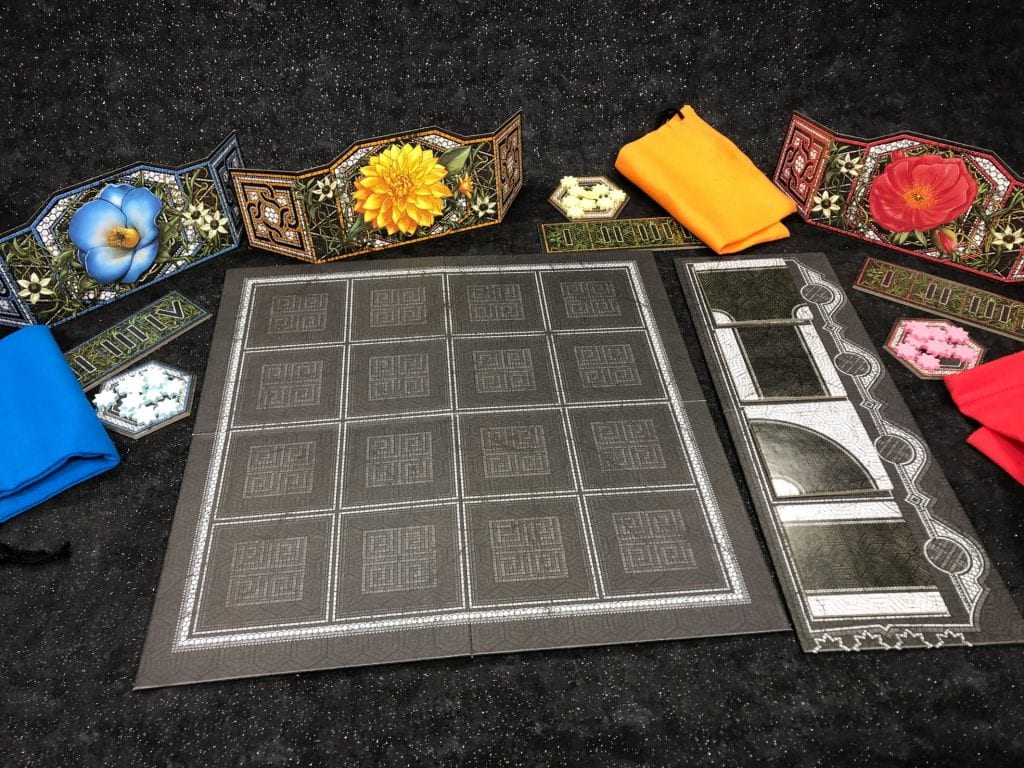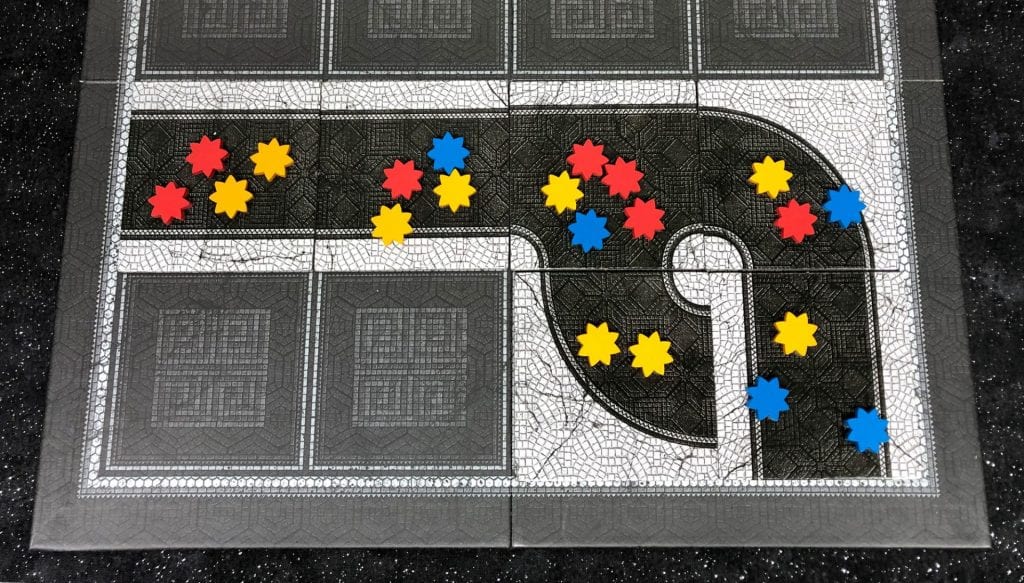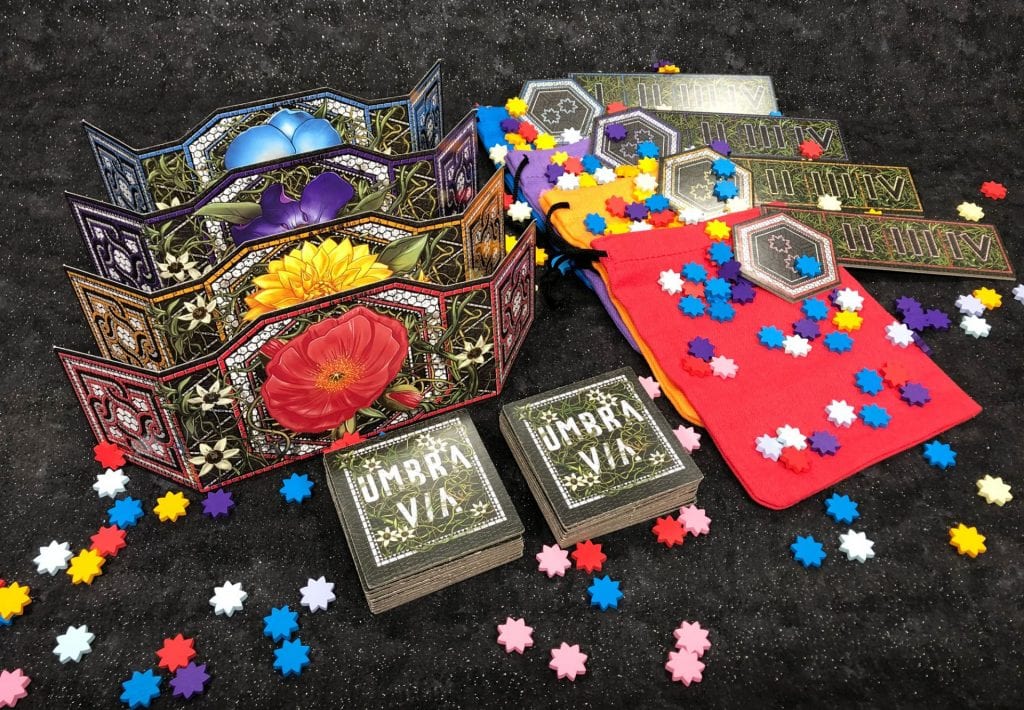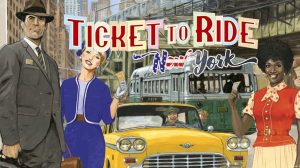Disclosure: Meeple Mountain received a free copy of this product in exchange for an honest, unbiased review. This review is not intended to be an endorsement.
Some games just draw you in.
Perhaps it’s the name, or the cover art, or maybe it’s a publisher you trust. When I saw pictures of Umbra Via, I connected with all three. The artwork is lush and organic, with tendrils of grass growing over what appears to be paving stones in the shape of an interesting name: Umbra Via (Latin for shadowy path). And Pandasaurus Games is quickly moving up my list of favorite publishers. The past year or 2 have seen them making big moves with really appealing games like Dinosaur Island, The Mind, Silver & Gold, Machi Koro Legacy, and Ctrl.
Umbra Via, winner of the 2019 Cardboard Edison Award, is the most recent release from Pandasaurus Games. Let’s see what makes this one special.

Umbra Via Overview
In Umbra Via players are attempting to be the first one to collect all of their Soul Flowers by placing Energy Flowers of their color onto paths on the game board. Once a path is closed off at both ends, the path is scored and the player with the largest number of Energy Flowers will collect Soul Flowers equal to the length of the path. Depending on the length of the path a 2nd or even 3rd place player might collect a smaller number of Soul Flowers. Once one player has collected all of their remaining Soul Flowers, the game ends.

Umbra Via Gameplay
Have each player take the items of their color, then place 11 Soul Flower tokens (the lighter color) onto their Soul Tile. Place the remaining Soul Flower tokens, and all of the Energy Flower tokens (the darker color) into their bag. Shuffle the Path tiles and set them aside. Set the game board in the center of the table, and the game is ready to begin.
Bidding
At the beginning of each round, draw 4 Path tiles and lay them face up on the Altar board; these are the tiles up for auction. In secret, each player draws 3 Flower tokens from their bag and assigns them in any manner they wish to their personal bidding board.

After all players have assigned their tokens, players lift their shields to reveal their bids, and place their Flower tokens onto the matching spaces on the Altar board. Players repeat this step a second time, until each player has placed 6 Flower tokens onto the Altar.
Placing Path Tiles
Next, the players evaluate which Path tile will be placed onto the main board first. The Path tile with the fewest Flower tokens on is placed first, the Path tile with the most Flowers is placed last. In the case of a tie for Flower tokens, the Path tiles are evaluated from left to right.
In order to determine who places the Path tile the Flower tokens are tallied and the player with the most Flowers wins the tile. Soul Flowers are worth 2, while Energy Flowers are worth 1.

When placing a Path tile, the player may place it on any empty spot on the game board, but may not rotate the tile from the original orientation on the Altar. Before placing a Path tile onto the main board, remove all Soul Flowers and discard them from the game.
Completing Paths & Summoning
If, when placing a Path tile, a player closes off a path, a Summoning occurs. During this time play stops while players determine which player has the majority.
Tally up the number of Energy Flowers from each player on the path and determine who has the largest amount. That player will collect 1 Soul Flower from their Soul Tile for each tile in the completed Path. All Energy Flowers are returned to their bag, along with any new Soul Flowers. The player with the next highest number of tokens on the path will earn half the number of Soul Flowers as the player above them (rounded down).

Continue bidding and placing Path tiles until one player earns back the last of their Soul Flowers, and wins the game.
Final Thoughts On Umbra Via
I always know I’m going to get a quality game from Pandasaurus. Their titles always have great curb appeal, and offer interesting gameplay. Umbra Via is no exception. It’s a melange of complementary mechanisms: tile laying, bidding, path completion, and area majority, all wrapped up in a 30-45 minute package — and that’s if you’re heavy on the analysis.
The gameplay flows really well between phases, and the breaks between bidding stages give you a glimpse into the mindsets of your opponents and offer you the chance to course correct.
“Anna is clearly going for the tile I want, because she placed all of her tokens there. But will she place more tokens there in the second bidding phase, or can I sneak in and outbid her”?
“I really want the tile in the 3rd spot, but if I put too many tokens down, it’ll get placed onto the board last which means it’s less useful to me”.
“Should I spread my tokens out on as many tiles as I can so that my opponents place tiles that contain my flowers; letting them do part of the work for me”?
But that insight can also be a double-edged sword: your opponents know you know these things and they’re actively working to avoid letting you make the most of their decisions. They are also paying close attention to your decisions so that they can do the same thing to you. While the game is simple to play, the bidding aspect really ratchets up the tension and uncertainty.
And that leads me to one of the downsides of this game, at least at 4 players; it’s a bit too chaotic. You only get 3 flowers to bid with which means you can’t cover all tiles, and with 3 other people bidding you won’t be as successful as you might with fewer players. While the chaos isn’t inherently a bad thing, in a shorter game like this it can lead to feelings of frustration if you’re never able to win an auction.

Another aspect is less concerning, but more noticeable. The flower tokens, while they are wood, are quite thin. For someone with hands as large as mine, it’s challenging to pick them up.
The quality of the flower tokens is a minor quibble, as the general production quality of Umbra Via – like its sensational, tense gameplay – is of great quality. If you’re looking for a fun and interesting family game, then Umbra Via might just be a great fit for you!












Add Comment